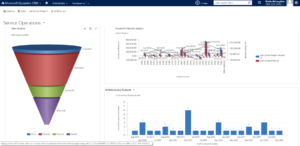 HVAC companies today are in a constant state of improvement, always looking for ways to be more efficient and to provide better service. Establishing and evaluating key performance indicators (KPIs) is the only way to truly know how successful your company is at providing superior service.
HVAC companies today are in a constant state of improvement, always looking for ways to be more efficient and to provide better service. Establishing and evaluating key performance indicators (KPIs) is the only way to truly know how successful your company is at providing superior service.
You can’t improve what you can’t measure, and KPIs allow HVAC service organizations to define, measure, monitor, and track performance to achieve their organizational goals. They can see where exactly they need to improve to increase profitability, provide better service, make technicians more productive while lowering business expenses.
A comprehensive HVAC service management software can help you analyze your KPIs and optimize your productivity. As an owner of an HVAC company or as head of service, you should measure and keep the following KPIs in mind:
Customer Satisfaction
Knowing the satisfaction rate of your customers is one of the most important KPIs to measure. In field service, satisfied customers make loyal customers that help you anticipate future profits. Customer satisfaction also leads to customer retention, which is great for the bottom line of your business. According to Aberdeen Research, companies that have a high level of customer satisfaction also have an 89% customer retention level. These companies experienced a 6.1% growth in service revenue and 3.7% growth in overall revenue as well.
Customer Retention
Existing customers are worth more than new ones, as the revenue a company generates from loyal customers can sustain a business. Customer acquisition is often expensive due to the time, resources, and efforts that need to be put into finding new clients. Retaining clients means having referrals and word-of-mouth marketing that can help you acquire new customers. Customer churn is a key warning that your company isn’t providing superior service to retain clients.
Revenue From Services
It is important for HVAC companies to be able to identify how much revenue comes from services in comparison to total company revenue; did we make money on that job? Are our maintenance contracts profitable? Are we giving away free service? How many customers are on service contracts? It is crucial for HVAC companies to measure how much revenue is being made from services so that business processes can be adjusted and improved.
Completed vs. Invoiced Jobs
If a technician has completed a job, but the customer has not been invoiced, you would want to know, right? The clock for service-to-cash starts ticking the moment the job is done, not when the customer is invoiced. That’s why it’s so important to stay on top of your company’s invoicing and billing cycle. The longer the lag time between the service and invoice dates, the greater the cash flow crunch you will have to deal with. An unsent invoice after completed work means missing revenue for your business.
Employee Productivity
What percentage of appointments do our techs arrive to on time? How long does it take them to complete a service appointment? How much time are they spending on job sites? Breaks? Overtime? Do they frequently upsell additional maintenance, products, or services? How many jobs are they completing each day? Who are our best performing technicians, and why? Knowing how productive your employees are can show you where their skill strengths and weaknesses lie. It can also show you whether more training is required, new techs are needed, or if you need to restructure your current team.
Employee Retention
As with acquiring new customers versus retaining current ones, knowing the rate at which your business is retaining employees is important to your business’ success. It is usually much cheaper to retain an existing employee than to find, hire, and train a new field service employee. The happier your technicians are, the more productive they will be.
Average Resolution Time
First-time fix rate is one of the most vital metrics in measuring field service performance. It is defined as the percentage of jobs that are resolved the first time a field technician visits and is a true measure of field service efficiency. A poor first-time fix rate not only reflects poor field service processes, but is also an early indicator of unhappy customers, likely customer attrition, and reduced service profitability.
It is critical for the success of your HVAC company to know exactly what your problem areas are. Does the thought of measuring all these KPI’s seem overwhelming? With a comprehensive field service software, all of this information can be automated and analyzed in easy to read charts and graphs any time, any place. If you can measure these aspects of your business, you can identify what you’re doing well and what needs improvement – and make better-informed business decisions based on the real-time data your business is already generating.
Contact FIELDBOSS to learn how to better serve your customers – and to help your business thrive.